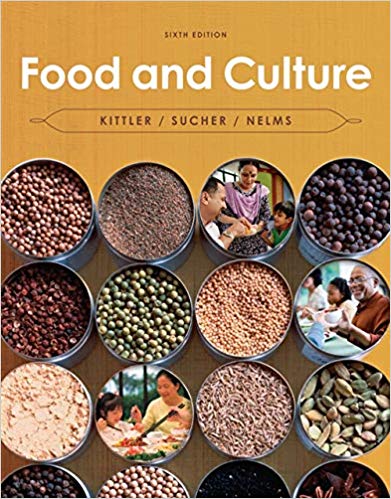Test bank for Food And Culture 6th Edition Kittler Sucher
Digital item No Waiting Time Instant DownloadISBN-10: 9780538734974 ISBN-13: 978-0538734974Publisher : Cengage Learning; 6th editionAuthors: by Pamela Goyan Kittler,Kathryn P. Suche, Marcia Nelms
In Stock
Original price was: $55.00.$24.00Current price is: $24.00.
Test bank for Food And Culture 6th Edition Kittler Sucher
Test Bank for Food and Culture 6eChapter 1: Food and Culture
Multiple Choice Questions
1. What is the fastest-growing ethnic group in the U.S.?
a. Latinos
b. Chinese
c. Asians
d. African American
2. Which of the following is a definition of culture?
a. The beliefs, attitudes, values, and practices of a community of individuals
b. The regional geography versus the local foods
c. The ability to choose fine wines and enjoyment of opera
d. Is determined by the country in which a person was born
e. All of the above
3. The multiplicity of ways in which humans use food is termed
a. food habits.
b. food culture.
c. food ways.
d. all of the above
4. The need for humans to experiment with food choices but at the same time be conservative is called:
a. the omnivore’s paradox.
b. assimilation.
c. the American paradox.
d. ethnocentrism.
5. The process of handing down the manners and understandings in common to a culture from one generation to the next would be a good definition for
a. bicultural.
b. assimilation.
c. enculturation.
d. acculturation.
e. intra-ethnic variation.
6. Children learn food preferences from valued or trusted others. Who has the least long-lasting influence?
a. Teachers
b. Peers
c. Older siblings
d. Parents
7. Culturally specific preferences become apparent around what age?
a. 2 years
b. 3-6 years
c. Teen years
d. Adulthood
8. Rules regarding _____ determine who can dine together.
a. commensalism
b. ethnocentrism
c. prejudice
d. class
9. Following the flavor principles model, herbs and spices:
a. help palatability.
b. disguise spoiled foods.
c. produce physiological responses.
d. all of the above
10. Cultural membership or social identity is defined by
a. culture.
b. race.
c. ethnicity.
d. acculturation.
11. According to the consumer food choice model, what factor(s) influence(s) food selection?
a. Taste
b. Well-being
c. Convenience
d. All of the above
e. a and c
12. How many ethnicities were identified by the Canadian census in 2006?
a. 200
b. 50
c. 10
d. 21
13. Complex rules that define how humans eat meals are called
a. traditions.
b. customs.
c. manners.
d. foodways.
14. Which is an example of an incorporation of food association?
a. Rare meat to build muscle
b. Walnuts to improve brain function
c. Eating of insects as a protein source
d. a and b
e. All of the above
15. Bread is often used as a symbol in many cultures. A symbolic use of bread might mean
a. bread representing an association with a religious value.
b. bread being eaten by almost every group of people.
c. bread type (whole wheat versus white) being used to show higher or lower status.
d. a and b
e. a and c


Reviews
There are no reviews yet.